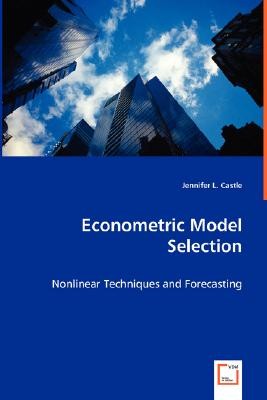
- We will send in 10–14 business days.
- Author: Jennifer L Castle
- Publisher: VDM Verlag Dr. Mueller E.K.
- Year: 2008
- Pages: 200
- ISBN-10: 3639004582
- ISBN-13: 9783639004588
- Format: 15.2 x 22.9 x 1.1 cm, minkšti viršeliai
- Language: English
- SAVE -10% with code: EXTRA
Reviews
Description
Selection and forecasting are integral to econometric modelling but a unified treatment is rarely considered. This book addresses both issues, with an application to UK inflation. The theme of model selection underpins all chapters of the book. The development of any econometric model requires model selection rules because economic processes are extremely complex and the underlying data generating process is unknown. Furthermore, different model selection rules may be required for in-sample modelling and for forecasting, when the data generating process is evolutionary, non-stationary, and unknown to the econometrician. This book develops methods for selecting nonlinear models, proposing an easy to implement algorithm which circumvents identification problems, and builds equilibrium correction mechanisms of inflation to examine their forecast performance against robust devices. The book provides a comprehensive treatment of model selection, demonstrating that general-to-specific selection tools are integral to modelling and forecasting in a non-stationary world, and should be an invaluable read to those building econometric models for fore-casting and policy evaluation.
EXTRA 10 % discount with code: EXTRA
The promotion ends in 22d.13:05:25
The discount code is valid when purchasing from 10 €. Discounts do not stack.
- Author: Jennifer L Castle
- Publisher: VDM Verlag Dr. Mueller E.K.
- Year: 2008
- Pages: 200
- ISBN-10: 3639004582
- ISBN-13: 9783639004588
- Format: 15.2 x 22.9 x 1.1 cm, minkšti viršeliai
- Language: English English
Selection and forecasting are integral to econometric modelling but a unified treatment is rarely considered. This book addresses both issues, with an application to UK inflation. The theme of model selection underpins all chapters of the book. The development of any econometric model requires model selection rules because economic processes are extremely complex and the underlying data generating process is unknown. Furthermore, different model selection rules may be required for in-sample modelling and for forecasting, when the data generating process is evolutionary, non-stationary, and unknown to the econometrician. This book develops methods for selecting nonlinear models, proposing an easy to implement algorithm which circumvents identification problems, and builds equilibrium correction mechanisms of inflation to examine their forecast performance against robust devices. The book provides a comprehensive treatment of model selection, demonstrating that general-to-specific selection tools are integral to modelling and forecasting in a non-stationary world, and should be an invaluable read to those building econometric models for fore-casting and policy evaluation.


Reviews